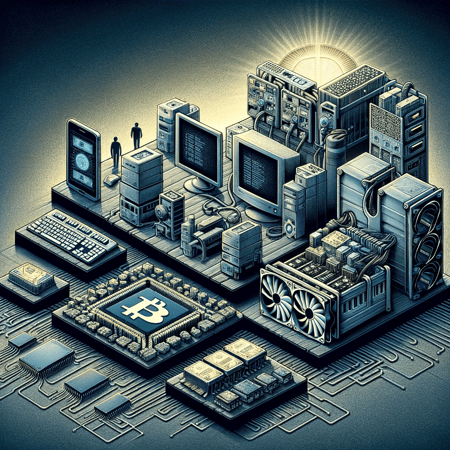A Brief Overview of Bitcoin Mining Hardware
Mining has always been the heartbeat that fosters the creation of new bitcoins and validates transactions on the blockchain. The task demands a high degree of computational prowess. Over the years the artillery for this task, the mining hardware, has evolved remarkably to meet the rising computational demands.

The Genesis: CPU Mining
The story begins in 2009, with Bitcoin's inception. The earliest miners usedCentral Processing Units (CPUs) for mining. CPUs, being general-purpose devices, were accessible to a wide swath of early enthusiasts. They allowed anyone with a computer to participate in the mining process. However, the inefficiency and slow computational speed of CPUs quickly became a limiting factor as more miners joined the fray and the network's difficulty level rose.
Emergence of GPU Mining
Not long after, the quest for better hardware led to the adoption of Graphics Processing Units (GPUs) around 2010. Unlike CPUs, GPUs have multiple cores and excel in parallel processing, significantly boosting the mining speed and efficiency. This shift marked the dawn of a new era in mining, propelling a faster transaction verification process and a subsequent rise in the network's hashrate.
FPGA Mining: A Step Towards Specialisation
The transition towards more specialised hardware led to the advent of Field-Programmable Gate Arrays (FPGAs) in the mining sphere around 2011. FPGAs, with their reprogrammable silicon chips, allowed miners to optimise the hardware for maximum hashrates while minimising power consumption. This phase was characterised by a blend of efficiency and performance, catering to the escalating computational requirements of bitcoin mining.
ASICs: The Apex of Specialisation
The relentless quest for efficiency birthed Application-Specific Integrated Circuits (ASICs) in 2013, which marked the pinnacle of specialised hardware for bitcoin mining. Engineered exclusively for mining purposes, ASICs presented a quantum leap in processing power and efficiency, drastically outperforming their predecessors. This phase also saw the emergence of mining pools and industrial-scale mining operations, further professionalising the mining ecosystem.
USB Miners
As a counter to the increasing centralisation from ASIC dominance, USB bitcoin miners emerged, offering a compact, portable and affordable mining solution for enthusiasts. While they stood no chance against the monumental hash power of ASICs, they offered a semblance of decentralisation, enabling individuals to partake in mining without colossal investments.
%20mining%20pickaxe%20is%20centrally%20placed%2c%20signifying%20Bitcoin%20mining.%20Surrounding%20.png?width=352&name=DALL%C2%B7E%202023-11-01%2011.11.54%20-%20Illustration%20on%20a%20white%20background.%20A%20modern%2c%20tech-inspired%20blue%20(%231D1057)%20mining%20pickaxe%20is%20centrally%20placed%2c%20signifying%20Bitcoin%20mining.%20Surrounding%20.png)

%20digital%20hourglass%20denoting%20the%20impending%20Bitcoin%20halving.%20Enci.png?width=352&name=DALL%C2%B7E%202023-11-01%2011.19.06%20-%20Illustration%20on%20a%20white%20background.%20At%20the%20heart%20of%20the%20image%20is%20a%20sleek%20blue%20(%231D1057)%20digital%20hourglass%20denoting%20the%20impending%20Bitcoin%20halving.%20Enci.png)